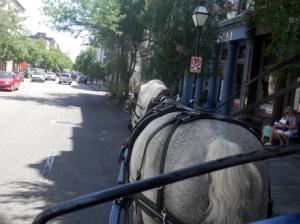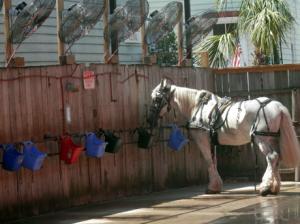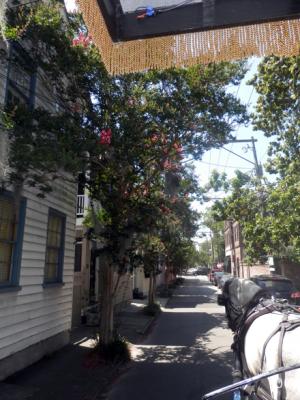By Nancy and Tommy Brannon
As one of the oldest cities in the U.S., Charleston, South Carolina has a lot going for it as a vacation destination: Revolutionary and Civil War history, low country cuisine, crafts markets featuring the famous Gullah baskets, ships, and several Atlantic shore beaches. So when this year’s American Horse Publications seminar, “Gallop N’ Grits,” was in Charleston, we made plans to attend.
The first afternoon’s activity was a carriage drive through Charleston, provided by Palmetto Carriage Works. What better way to sight see the narrow streets of historic Charleston than behind the handsome grey rump of Miley (a gelding named after Miley Cyrus)? The narrow city streets were originally constructed when horses and carriages were the primary transportation.
As his passengers were all horse people, the driver spent a majority of his time explaining the care of the carriage horses, while showing some of the historic aspects of Charleston.
The family owned and operated business, for 37 years, maintains a herd of 66 horses and mules, 44 of which are working stock, so they can be rotated regularly. They are kept on a farm outside Charleston On John’s Island when not stabled in the downtown barn. Tommy Doyle, owner and general manager, says he gets his horses from Amish horse dealers in Pennsylvania. Carriage work is a second “career” for horses who are being retired from farm work. Doyle has a system for taking care of the horses and “it works,” he says.
Charleston’s carriage businesses are highly regulated by the city, with ten pages of regulations regarding care of the animal, carriage specifications, traffic, weather, and excrement control. In fact, each rider on the carriage got a copy of the city’s municipal code. Each horse is registered by name and “the city tells us where to go,” Doyle explained. The horse’s temperature is taken regularly and it has to be below 103° F for the horse to work (normal is 100 to 101°). If an animal’s temperature becomes slightly elevated, the animal is taken out of service and cooled down until the temperature returns to normal. The horses work an average of 4-5 hours/day, 5 days/week. If the temperature reaches 98°F or the heat index reaches 125°F, the horses do not work. Between “tours,” the horses rest under misting fans in front of buckets of water. Mules are popular for carriage tours “because they do a better job of regulating their body temperature,” Doyle said. “We’ve never had one incident of heat stress or stroke in over 30 years of business.”
The tourist industry provided $8 billion to Charleston last year. With controversy in many cities across the U.S. about urban carriage horses, Charleston and Palmetto Carriage Works provide a model for putting horse’s health care as priority. For more information, visit http://www.palmettocarriage.com/
As one of the oldest cities in the U.S., Charleston, South Carolina has a lot going for it as a vacation destination: Revolutionary and Civil War history, low country cuisine, crafts markets featuring the famous Gullah baskets, ships, and several Atlantic shore beaches. So when this year’s American Horse Publications seminar, “Gallop N’ Grits,” was in Charleston, we made plans to attend.
The first afternoon’s activity was a carriage drive through Charleston, provided by Palmetto Carriage Works. What better way to sight see the narrow streets of historic Charleston than behind the handsome grey rump of Miley (a gelding named after Miley Cyrus)? The narrow city streets were originally constructed when horses and carriages were the primary transportation.
As his passengers were all horse people, the driver spent a majority of his time explaining the care of the carriage horses, while showing some of the historic aspects of Charleston.
The family owned and operated business, for 37 years, maintains a herd of 66 horses and mules, 44 of which are working stock, so they can be rotated regularly. They are kept on a farm outside Charleston On John’s Island when not stabled in the downtown barn. Tommy Doyle, owner and general manager, says he gets his horses from Amish horse dealers in Pennsylvania. Carriage work is a second “career” for horses who are being retired from farm work. Doyle has a system for taking care of the horses and “it works,” he says.
Charleston’s carriage businesses are highly regulated by the city, with ten pages of regulations regarding care of the animal, carriage specifications, traffic, weather, and excrement control. In fact, each rider on the carriage got a copy of the city’s municipal code. Each horse is registered by name and “the city tells us where to go,” Doyle explained. The horse’s temperature is taken regularly and it has to be below 103° F for the horse to work (normal is 100 to 101°). If an animal’s temperature becomes slightly elevated, the animal is taken out of service and cooled down until the temperature returns to normal. The horses work an average of 4-5 hours/day, 5 days/week. If the temperature reaches 98°F or the heat index reaches 125°F, the horses do not work. Between “tours,” the horses rest under misting fans in front of buckets of water. Mules are popular for carriage tours “because they do a better job of regulating their body temperature,” Doyle said. “We’ve never had one incident of heat stress or stroke in over 30 years of business.”
The tourist industry provided $8 billion to Charleston last year. With controversy in many cities across the U.S. about urban carriage horses, Charleston and Palmetto Carriage Works provide a model for putting horse’s health care as priority. For more information, visit http://www.palmettocarriage.com/











